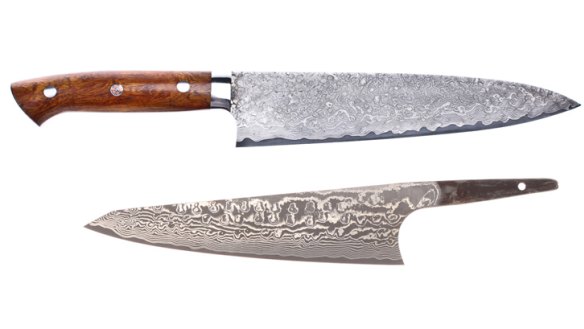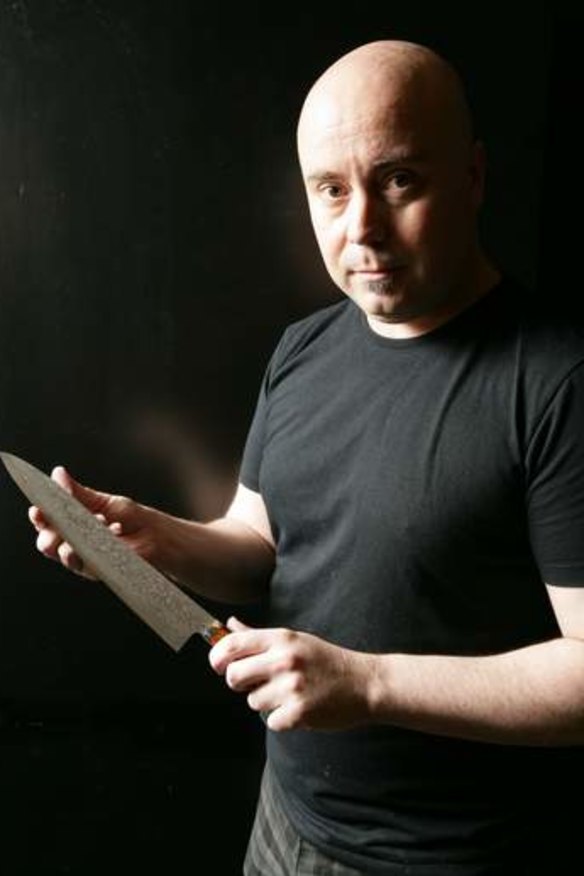Reign of steel
Japanese kitchen knives are the world's best — but these blades come with a sharp warning.

SOMETHING IS HOT IN RESTAURANT kitchens right now. Even hotter than Trinidad Scorpion Butch T, the world's most scorching chilli.
It is a Japanese knife, and for chefs who do not own one, it is likely to be high on their wish-list.
''I have a very lovely selection of knives,'' says the head chef at Chin Chin in Melbourne, Benjamin Cooper. ''A custom-made blue-steel sakai deba with an ebony handle, and two wa-gyutos, one hammer-finished from Fukui.''

Deba? Wa-gyuto? Fukui? To enter the world of Japanese knives, a crash course in Japanese is needed.
The subject is so complex ''it takes me two to three years to train a new staff member'', says Leigh Hudson, who opened the first Chef's Armoury, which specialises in Japanese knives, in Sydney three years ago. He now runs the recently opened Melbourne branch in Richmond.
Japanese knives are the result of 800 years of craftsmanship. In most cases, they are made by the same small companies and co-operatives that made samurai swords, or katanas. The best of them are handmade from hand-forged steel. The very best - and most expensive - will be signed, with the maker's name etched into the blade.
Some are made by folding more than 100 layers of Damascus steel around a high-carbon stainless steel core; others are made from hammer-forged stainless steel. Japanese stainless steel is harder than European steel when measured by the Rockwell scale; a typical German knife will rate 52-56, while the Japanese will score 58-65, so it will keep its edge longer.
However, Japanese knives are about more than numbers. ''I never felt comfortable using German or European knives,'' says the head chef at Woollahra's Buzo, Mitch Orr. ''They're too harsh. The Japanese knives are subtler, beautifully made, pretty to look at and amazing to use.''
One of the Hudson-trained employees at Chef's Armoury, Eddie Stewart, gave Epicure a tour of the knives and the experience of using them. We learnt there's a Japanese knife for just about every cutting job. For example, there's the one-sided yanagiba (sharpened on one side only) for sashimi, the nakiri for vegetables, the sujihiki for slicing boneless meat and the sakimaru takobiki, which is an octopus knife. We saw an example being made by one of the Sakai Takayuki brand's most experienced forgers, Keijiro Doi. Stewart shows me how to have our knives custom-made by choosing between the blades of two regions, Fukui and Sakai, then choosing from a range of handle materials, including Australian materials such as Huon pine and silky oak. ''A lot of the Fukui knives go to home cooks,'' Stewart says. ''Our sales are 50-50 domestic and professional.''
By now we're itching to get our mitts on one of these beautiful instruments. We're led to a cutting board and given an orange and three different knives.
First, a MCUSTA gyuto - a chef's knife - made of VG10 stainless steel. It's much better than any knife we've used thus far. An excellent entry-level knife for the price.
Second, a Fukui 150-millimetre blue-steel petty knife. It's a utility knife, very sharp but also very light - too light. Finally, a knife chefs might sell their soul for: a Saji ironwood 210 gyuto with a cow-bone handle; the blade is 100 layers of Damascus steel wrapped around a diamond-hard core of R2 powder steel. R2? It's a secret formula. This beautiful blade turns everything it cuts into butter. A good Japanese knife, Cooper says, ''becomes a part of your arm faster. You use it differently; you don't put anywhere as much pressure on it.''
''I liken Japanese knives to tattoos,'' he says. ''Once you've got one, you can't stop.''
Found in translation
Deba Fish filleter.
Gyuto/wa-gyuto Chef's knife.
Hocho Cooking knife.
Hon kasumi Traditional style blade made by joining soft iron and hard steel.
Honyaki A single piece of steel for a blade forged and tempered, harking back to katanas, or samurai swords.
Nakiri Rectangular vegetable knife.
Petty Utility knife.
Santoku ''Three virtues'': chopping, slicing, dicing.
Usuba Traditional vegetable knife.
Yanagiba Sashimi slicer.
Restaurant reviews, news and the hottest openings served to your inbox.
Sign up